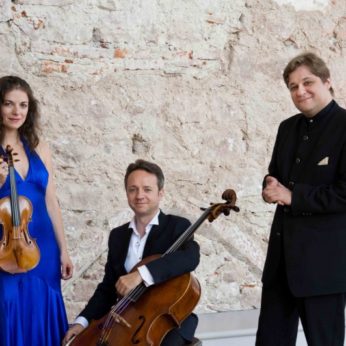Composer: Franz Schubert (b. 1797 - d. 1828)
Performance date: 29/06/2015
Venue: St. Brendan’s Church
Composition Year: 1827
Duration: 00:09:00
Recording Engineer: Richard McCullough, RTÉ lyric fm
Instrumentation: 2vn, va, vc, pf
Instrumentation Category:Trio
Artists:
Liana Gourdjia -
[violin]
Marc Coppey -
[cello]
Peter Laul -
[piano]

Little is known of
Schubert’s intentions for this Notturno movement, although it is widely
thought to be a rejected movement from the B-flat Major trio. The melody of the
first theme is very similar to a work song (‘Arbeitslied’) from upper Austria
with an easy rhythm to which workers would hit their hammers in unison. It is
said that in 1825, while on holiday in Gmunden, Schubert passed a group of pile
drivers working on the road and paused to listen to their song. The manuscript
is lost, however the Notturno was written soon after this trip, in 1826
or 1827.
Although
Schubert’s Notturno was written only a short time before his death in
1828, there is no trace of his impending fate hidden in this piece. Instead,
this Adagio is as an uncharacteristically calm, blissful work from a
composer known for the bittersweet melodrama of his lieder and chamber
music. One cannot listen to the Notturno
without thinking of the Adagio movement of Schubert’s ‘Cello’ Quintet D.
956. Aside from their identical tempo markings, both share similar dotted
sixteenth note rhythms, ternary form, and a playful shift between arco and
pizzicato in the strings. However,
unlike the Adagio of the ‘Cello’ Quintet, the Notturno never escalates
emotionally, even at the height of its active moments; it is still a stately
character.
The opening of the
Notturno is marked Appassionato, however the serene chords in the
piano followed by the opulent melody in the strings is anything but fiery. In
the first several measures, the piano’s block chords are like a strummed harp
as the strings sing their quiet melody above and eventually take on the role of
the harp with their pizzicati. If the Adagio of the ‘Cello’ Quintet is
the ascent to heaven, in the Notturno we have now arrived.
As the strings
quietly fade to nothing, a syncopated rumble in the piano signals a new theme.
Racing sixteenth note triplets give the section new life and the strings
crescendo continuously while still maintaining their grand character until
shrinking back to a pianissimo and longer sustained notes, eventually
transitioning back to the first theme. This time, the theme is more
lighthearted as violin and cello pizzicato back and forth, but the return is
short lived as the noble second theme returns. The first theme eventually
returns for the final time, calm and serene as it was in the beginning, but
with a trill in the piano, a playful wink to the energy of the second
theme.
Copyright © 2025 West Cork Music. All rights reserved.
Designed and developed by Matrix Internet